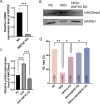IDH2 and GLUD1 depletion arrests embryonic development through an H4K20me3 epigenetic barrier in porcine parthenogenetic embryos
- PMID: 39318125
- PMCID: PMC11668942
- DOI: 10.24272/j.issn.2095-8137.2024.219
IDH2 and GLUD1 depletion arrests embryonic development through an H4K20me3 epigenetic barrier in porcine parthenogenetic embryos
Abstract
Isocitrate dehydrogenase 2 (IDH2) and glutamate dehydrogenase 1 (GLUD1) are key enzymes involved in the production of α-ketoglutarate (α-KG), a metabolite central to the tricarboxylic acid cycle and glutamine metabolism. In this study, we investigated the impact of IDH2 and GLUD1 on early porcine embryonic development following IDH2 and GLUD1 knockdown (KD) via double-stranded RNA (dsRNA) microinjection. Results showed that KD reduced α-KG levels, leading to delayed embryonic development, decreased blastocyst formation, increased apoptosis, reduced blastomere proliferation, and pluripotency. Additionally, IDH2 and GLUD1 KD induced abnormally high levels of trimethylation of lysine 20 of histone H4 (H4K20me3) at the 4-cell stage, likely resulting in transcriptional repression of embryonic genome activation (EGA)-related genes. Notably, KD of lysine methyltransferase 5C ( KMT5C) and supplementation with exogenous α-KG reduced H4K20me3 expression and partially rescued these defects, suggesting a critical role of IDH2 and GLUD1 in the epigenetic regulation and proper development of porcine embryos. Overall, this study highlights the significance of IDH2 and GLUD1 in maintaining normal embryonic development through their influence on α-KG production and subsequent epigenetic modifications.
异柠檬酸脱氢酶2(IDH2)和谷氨酸脱氢酶1(GLUD1)是参与α-酮戊二酸(α-KG)生成的关键酶,α-KG是三羧酸循环和谷氨酰胺代谢中的重要代谢物。在该研究中,我们通过显微注射dsRNA敲低了IDH2和GLUD1的表达,重点研究了它们对早期猪胚胎发育的影响。敲低导致4细胞及囊胚期猪胚胎胞内α-KG水平降低,进而引起胚胎发育延迟、囊胚形成率下降、细胞凋亡增加、卵裂球增殖和多能性降低。此外,IDH2和GLUD1的敲低导致在4细胞阶段组蛋白H4赖氨酸20三甲基化(H4K20me3)水平异常升高,可能导致与胚胎基因组激活(EGA)相关基因的转录抑制。重要的是,赖氨酸甲基转移酶5C(KMT5C)的敲低和外源性α-KG的补充降低了H4K20me3的表达,部分恢复了这些缺陷,表明IDH2和GLUD1在表观遗传调控和猪胚胎正常发育中的关键作用。该研究强调了IDH2和GLUD1在通过影响α-KG的生成及其后续表观遗传修饰来维持正常胚胎发育中的重要性。.
Keywords: A-ketoglutarate; Embryonic development; GLUD1; H4K20me3; IDH2.
Conflict of interest statement
The authors declare that they have no competing interests.
Figures









References
-
-
Cao XW, Chen YR, Wu B, et al. 2020. Histone H4K20 demethylation by two hHR23 proteins. Cell Reports, 30(12): 4152–4164. e6.
-
MeSH terms
Substances
LinkOut - more resources
Full Text Sources
Miscellaneous
